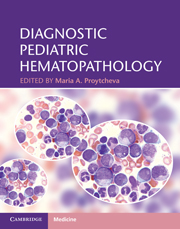Book contents
- Frontmatter
- Contents
- List of contributors
- Acknowledgements
- Introduction
- Section 1 General and non-neoplastic hematopathology
- Section 2 Neoplastic hematopathology
- 10 Chromosome abnormalities of hematologic malignancies
- 11 Expression profiling in pediatric acute leukemias
- 12 Myeloproliferative neoplasms
- 13 Myelodysplastic/myeloproliferative neoplasms
- 14 Myelodysplastic syndromes and therapy-related myeloid neoplasms
- 15 Acute myeloid leukemia and related precursor neoplasms
- 16 Hematologic abnormalities in individuals with Down syndrome
- 17 Precursor lymphoid neoplasms
- 18 Advances in prognostication and treatment of pediatric acute leukemia
- 19 The effect of chemotherapy, detection of minimal residual disease, and hematopoietic stem cell transplantation
- 20 Pediatric small blue cell tumors metastatic to the bone marrow
- 21 Pediatric mature B-cell non-Hodgkin lymphomas
- 22 Pediatric mature T-cell and NK-cell non-Hodgkin lymphomas
- 23 Hodgkin lymphoma
- 24 Immunodeficiency-associated lymphoproliferative disorders
- 25 Histiocytic proliferations in childhood
- 26 Cutaneous and subcutaneous lymphomas in children
- Index
- References
16 - Hematologic abnormalities in individuals with Down syndrome
from Section 2 - Neoplastic hematopathology
Published online by Cambridge University Press: 03 May 2011
- Frontmatter
- Contents
- List of contributors
- Acknowledgements
- Introduction
- Section 1 General and non-neoplastic hematopathology
- Section 2 Neoplastic hematopathology
- 10 Chromosome abnormalities of hematologic malignancies
- 11 Expression profiling in pediatric acute leukemias
- 12 Myeloproliferative neoplasms
- 13 Myelodysplastic/myeloproliferative neoplasms
- 14 Myelodysplastic syndromes and therapy-related myeloid neoplasms
- 15 Acute myeloid leukemia and related precursor neoplasms
- 16 Hematologic abnormalities in individuals with Down syndrome
- 17 Precursor lymphoid neoplasms
- 18 Advances in prognostication and treatment of pediatric acute leukemia
- 19 The effect of chemotherapy, detection of minimal residual disease, and hematopoietic stem cell transplantation
- 20 Pediatric small blue cell tumors metastatic to the bone marrow
- 21 Pediatric mature B-cell non-Hodgkin lymphomas
- 22 Pediatric mature T-cell and NK-cell non-Hodgkin lymphomas
- 23 Hodgkin lymphoma
- 24 Immunodeficiency-associated lymphoproliferative disorders
- 25 Histiocytic proliferations in childhood
- 26 Cutaneous and subcutaneous lymphomas in children
- Index
- References
Summary
Introduction
Down syndrome (DS) was first reported in 1866 [1], but likely recognized much earlier [2, 3]. DS is caused by an extra copy of chromosome 21 (whole or partial) and is the most common chromosomal abnormality in the live newborn, with a prevalence estimated at 1 in 644–733 births in the United States [4, 5]. This prevalence will likely change because of delayed maternity, which is associated with increased risk of DS [6], and because of simpler and less invasive prenatal diagnosis of DS [7, 8]. Patients with DS have numerous consistent and variable clinical presentations that include mental retardation, characteristic facies, congenital heart defects, and gastrointestinal abnormalities.
The hematologic abnormalities associated with DS and their diagnostic features are detailed in this chapter.
Hematologic abnormalities in the DS newborn
DS newborns can have transient thrombocytopenia, polycythemia, or neutrophilia. They rarely present with unexplained thrombocytosis, anemia, or neutropenia [5], which are most likely unrelated to DS.
Synonyms
Currently, no one has coined a unique term for this phenomenon and it is usually referred to descriptively as hematologic abnormalities in the newborn/neonates with DS [5, 9, 10]. This chapter will use the term hematologic abnormalities in the newborn with DS (HANDS).
Epidemiology
Up to 80%, 66%, and 34% of DS newborns have neutrophilia, thrombocytopenia, and polycythemia, respectively [5, 9, 10]. These hematological abnormalities spontaneously resolve by three weeks of age [9].
- Type
- Chapter
- Information
- Diagnostic Pediatric Hematopathology , pp. 310 - 322Publisher: Cambridge University PressPrint publication year: 2011
References
- 2
- Cited by



